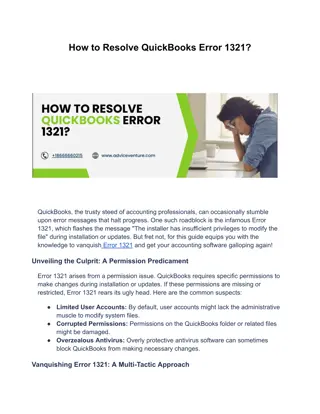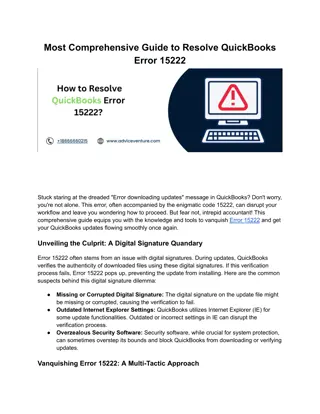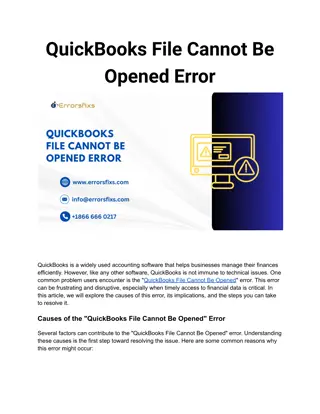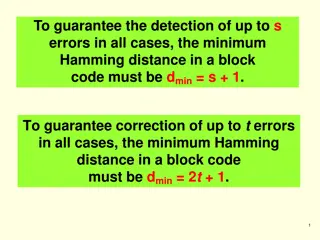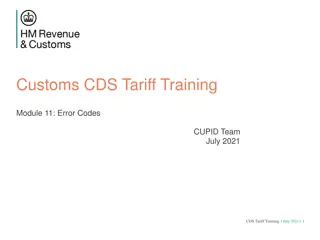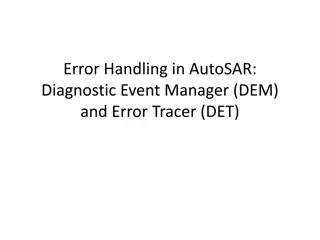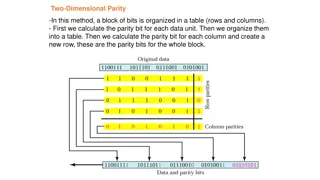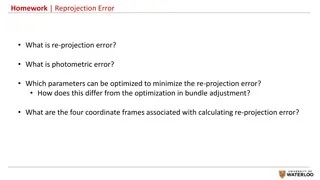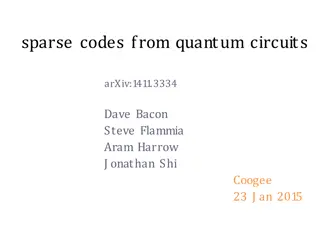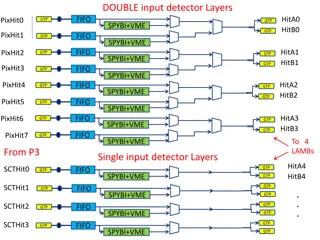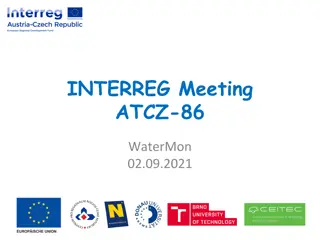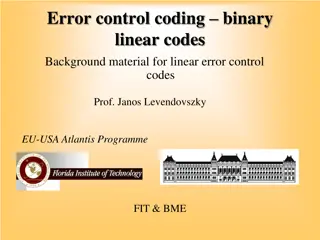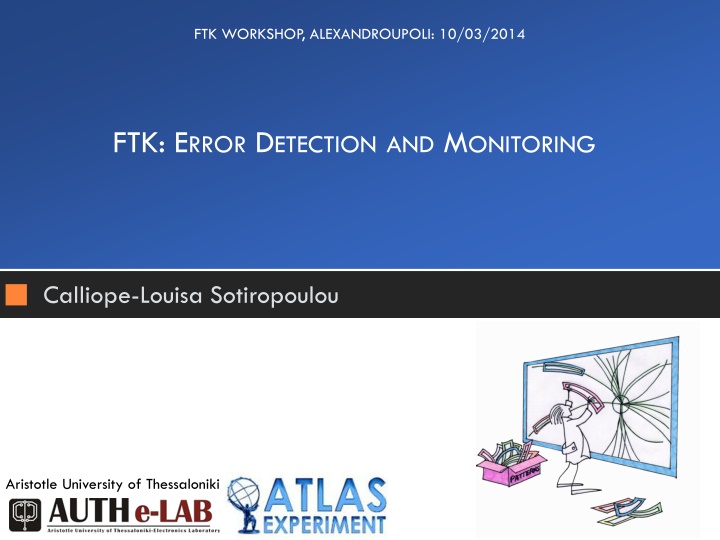
Error Detection and Monitoring Tools in FTK Workshop
Explore the tools for error detection and monitoring discussed in the FTK Workshop, including CRC, invalid input, lost sync, FIFO overflow, and more. Learn about synchronization logic modules, spy buffers, and time measurements for effective monitoring.
Uploaded on | 2 Views
Download Presentation

Please find below an Image/Link to download the presentation.
The content on the website is provided AS IS for your information and personal use only. It may not be sold, licensed, or shared on other websites without obtaining consent from the author. If you encounter any issues during the download, it is possible that the publisher has removed the file from their server.
You are allowed to download the files provided on this website for personal or commercial use, subject to the condition that they are used lawfully. All files are the property of their respective owners.
The content on the website is provided AS IS for your information and personal use only. It may not be sold, licensed, or shared on other websites without obtaining consent from the author.
E N D
Presentation Transcript
FTK WORKSHOP, ALEXANDROUPOLI: 10/03/2014 FTK: ERROR DETECTIONAND MONITORING Calliope-Louisa Sotiropoulou Aristotle University of Thessaloniki
FTK Tools for Monitoring Two front approach: Tools for error detection CRC, Invalid Input, Lost Sync, FIFO overflow, Truncated output Tools for performance monitoring Execution cycles measurement 2
FTK HW Tools for Monitoring Synchronization Logic Module Spy Buffers and their freeze logic Error Registers and Flags VME (and not only) Error Registers Time measurements (execution cycles) 3
Synchronization Logic Module (Sync Module) Input FIFOs An End Event (EE) word, which includes the event tag, separates hits belonging to different events. Data in different streams synchronized to guarantee that hits belonging to the same event are being processed by the AM patterns. have to be FPGA logic It also applies to boards with multiple-parallel data streams. As soon as the first EE word arrives in one stream it is stopped and waits for all streams to receive an EE word. EE words must match or Lost Sync 4
Synchronization Logic Module (Sync Module) Issues to be addressed/decided: Report only Lost Sync or which streams have Lost Sync ? First case: Just compare all EE words and report if they don t match Second case: Compare with a reference EE word and report which streams don t match together with the reference EE word How do we decide which is the valid (reference) EE word? Internal counter: Increment LVL1ID by one for each event Must make sure even empty events are received and take into account the LVL1ID reset after overflow (how?) Majority vote: Identify which is the EE word in the majority of streams and consider this one to be the valid More complex logic but error proof, not as fast? (to be looked into) 5
Sync Module Old Version First version for the AMBFTK during summer by Dimitris Currently under development for the AMBSLP Panos presentation next 6
INPUT FIFOs as derandomizers Spy Buffers: what are they? Pointer: incremented each time a word is popped from FIFO or sent to output. When it overflows it wraps around and an overflow flag is set circular memory EE TAG Hold IN EE TAG FIFO EE TAG EE TAG OUT Hold IN TWO MODES: SPY or FREEZE FIFO OUT Hold To be read by VME Copying data during run
INPUT FPGAs (AMBFTK) Spy Buffer Location 8
Spy Buffers Issues to be addressed/decided: Size In the Input chip ( HIT ) we have 12 streams: 12 Input FIFOs + 12 VME FIFOS + 12 Spy buffers quite a lot of buffering Replace the VME FIFOs with the Spy Buffers? Format Word size is different for the Input and different for the Output of the AMB. If storing of extra information is decided (e.g. timing information) then an extra info word per data word could be added Behavior When should we freeze the Spy Buffers? 9
Spy Buffer Freeze Two cases One bit in the EE word received on input stream means freeze immediately after you have finished to process the current event . The event to be monitored will be chosen by DF that will set the EE bit into all FTK streams In case of a severe error : Freeze is sent immediately to the previous board together with the event tag meaning Freeze after processing current event . Or freeze as soon as the freeze is received. 11
FTK Monitoring Requirements (AMB examples) CRC error : for each link (12 streams) checksum could be monitored (not currently supported). Error detection should be registered in a 12 bit word FIFO Overflow : each FIFO full flag should produce error if set. Again 12 bit word. Invalid Input data : for example invalid HIT from ROD (?) Lost Synchronization : event tags in different streams do not match 12 bit word Truncated output : too many roads in output 16 bit word 12
FTK: Common Error Word Proposal In the FTK Monitoring Kick Off Meeting it was proposed to use a common error word format in the whole FTK system This word should be propagated from one board to the next, being updated by every board s error status 32bits available for error identification in the EE word Use 16 bits for the error bits Use 16 bits for the board encoding (Identifying the board that caused the error) 13
FTK: Common Error Word Proposal Error bits format Use the 8 least significant bits (LSBs) for General Errors (Common to all boards) Use the 8 most significant bits (MSBs) for Board Specific Errors General (Common) Error bits (bits 0 7) CRC Error FIFO Overflow Loss of Sync Truncated Output Invalid Input Data Internal Overflow (Two bits still available) 14
FTK: Common Error Word Proposal Board Specific Error Bits (bits 8 15) Some of the Board Specific Error Flags could trigger a General (Common) Error Flag (e.g. FTK_IM Pixel Clustering Error Flags) Dropped Hits Set Common Invalid Input Data Full LIFO Set Common Internal Overflow Full Circ Buff Set Common Internal Overflow FE order Set Common Invalid Input Data Loss of Sync Set Common Loss of Sync 15
FTK: Common Error Word Proposal Board Encoding (Board Identification) Use 16 bits to identify the board causing the error Use the 8 least significant bits to encode the boards using one bit per board. Each Board in the pipeline will use an OR to add its bit in the error word. FTK_IM DF (for errors received from another DF board) DF (for errors caused by the current DF board) AUX AMB pSSB Will the 2 types of SSB boards have separate monitoring or not? fSSB FLIC 16
FTK: Common Error Word Proposal Tower Encoding (Tower Identification) Use the 8 most significant bits to identify the tower Starting from the AUX board the identifier will be tower_number mod 8 which will return a number from 0 up to 7. This will be transformed to a single bit: 0 bit 8 1 bit 9 2 bit 10 3 bit 11 etc. So each tower from an 8 tower group will have one specific bit 17
FTK: Common Error Word Proposal Tower Encoding (Tower Identification) In the FLIC 8 channels are received and each channel propagates the information of 8 towers Therefore if one bit is assigned to each tower and an OR is used to propagate the tower identifier in the error word to the FLIC we will be able to trace how many and whichtowers produced an error by reading the tower identifier 18
FTK: Common Error Word Proposal Error Bits: Inv. Input Data Trunc out Loss Sync FIFO O/flow Int. CRC O/flow Undefined 15 14 13 12 11 10 9 8 7 6 5 4 3 2 1 0 Board Specific General (Common) Board/Tower Identifier AUX DF2 DF1 FTK_IM pSSB AMB FLIC fSSB 15 14 13 12 11 10 9 8 7 6 5 4 3 2 1 0 Tower Identifier Board Identifier 19
FTK: Common Error Word Proposal Example: AUX DF2 DF1 FTK_IM pSSB AMB FLIC fSSB 0 0 1 0 0 1 0 0 0 0 0 1 1 0 0 0 Tower Identifier Board Identifier Inv. Input Data Trunc out Loss Sync FIFO O/flow Int. CRC O/flow Undefined 0 0 0 0 0 0 0 0 0 0 0 0 0 1 0 0 Board Specific General (Common) There was a Loss of Sync in an AMB and an AUX on Tower 2 and/or Tower 5. (This could mean there was Loss of Sync in an AUX and an AMB on both towers, or in an AUX on Tower 2 and an AMB on Tower 5 etc. By reading the spy buffers or the VME error registers this will be clear.) 20
32bit Error Word Trunc out Loss Sync FIFO O/flow Int. AUX DF2 DF1 FTK_IM CRC pSSB AMB FLIC fSSB O/flow Undefined 31 30 29 28 27 26 25 24 23 22 21 20 19 18 17 16 15 14 13 12 11 10 9 8 7 6 5 4 3 2 1 0 Tower Identifier Board Identifier Board Specific General (Common) Example from FTK_IM: Inv. Input Data Full Circ Buff Trunc out Loss Sync FIFO O/flow Int. Loss Sync FE order Full LIFO Dropped Hits CRC AUX DF2 DF1 FTK_IM O/flow pSSB AMB FLIC fSSB Undefined 0 0 0 1 0 0 0 0 0 0 0 0 0 1 0 0 0 0 0 0 0 0 0 0 0 0 0 0 0 0 0 1 Board Specific General (Common) Tower Identifier Board Identifier A Loss of Sync occurred in the Pixel Clustering Module of the FTK_IM 21
Time measurements (Local vs. Global) Local (per board) Implement a counter on each chip together with each Spy Buffer: Same size, same operating frequency Initialize on Init_event , start on first word received, stop on EE, store the value in the Spy Buffer Execution time per event/per processing element and execution time per event/per board Extra local time measurements (if necessary) Time of empty FIFOs (initialize on FIFO_empty ) Time of full/HOLD FIFOs (initialize on FIFO_full ) Could be stored periodically in the Spy Buffer with a dedicated word 22
Time measurements (Local vs. Global) Global (System) Processing Time AMBoard 4 DOs 4 HWs Final Fit-HW 4 TFs DF ROS FLI C Do we want to have Global (System) Processing Time? Yes... Do we want to measure the data delay from the detector? Then we need the L1 accept at least for the DF board At this point we can only add up the processing time per event from each board (without interconnection delays etc.) just to get a very rough estimate 23
Conclusions FTK Monitoring Tools are somewhat defined and development has been initialized for most of the boards Questions that need addressing How extensive and strict should monitoring be (e.g. Loss of Sync reporting) Define an error word format which are the error flags we actually need Presented in last FTK weekly meeting The Error Word is currently being defined for the FTK_IM Define time measurements requirements 24




